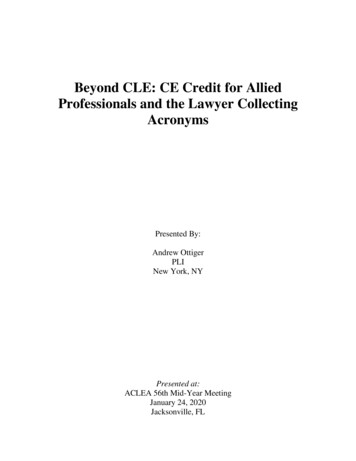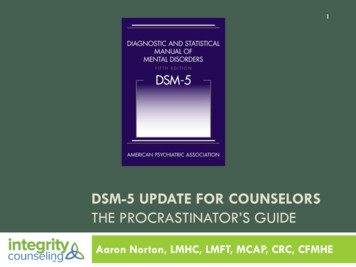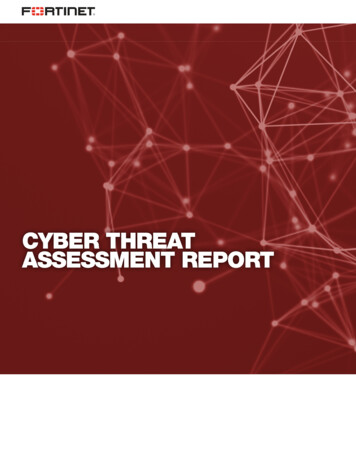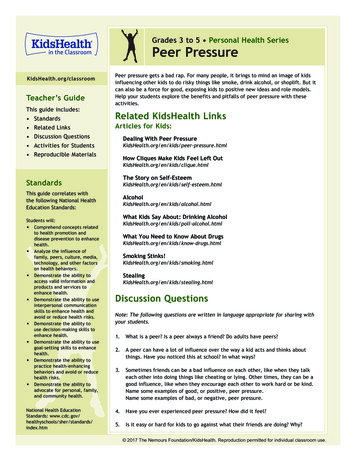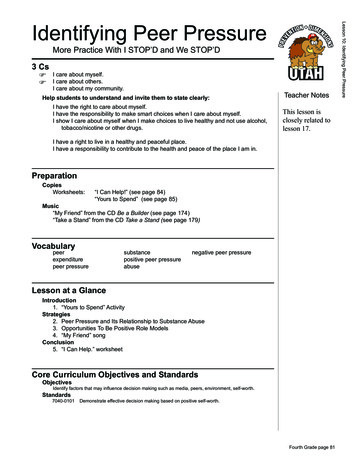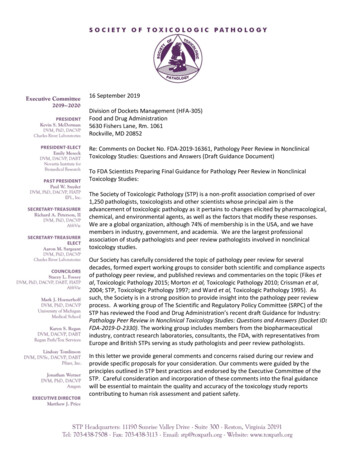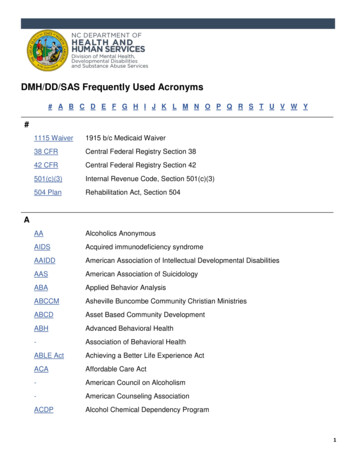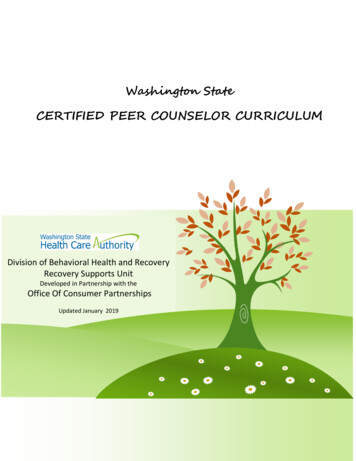
Transcription
Washington StateCERTIFIED PEER COUNSELOR CURRICULUMDivision of Behavioral Health and RecoveryRecovery Supports UnitDeveloped in Partnership with theOffice Of Consumer PartnershipsUpdated January 20190
Table of ContentsWelcome .page 2Module 1: Defining Your Role .page 7Module 2: Forming Peer Partnerships. page 19Module 3: Working From a Trauma Informed Perspective. page 45Module 4: Ethics and Boundaries in Peer Support . page 59Module 5: Cross-Cultural Partnerships . page 67Module 6: Supporting Goal-Setting . page 81Module 7: Treatment Planning, Documentation and Supervision . page 95Module 8: Facilitating Groups for Recovery . page 111Module 9: Supporting Self-Advocacy Efforts. page 121Module 10: Planning for Success as a CPC. page 135Appendices . page 141Appendix 1: References . page 141Appendix 2: Curriculum Contributors. page 144Appendix 3: Glossary . page 145Appendix 4: Acronyms . page 157Appendix 5: HIPAA . page 161Appendix 6: ADA (Americans with Disabilities Act) . page 162Appendix 7: 2016 BHO Map . page 166Appendix 8: Additional Materials . page 167Appendix 9: Online Course Review . page 1721
INTRODUCTION: Welcome.Welcome to the Certified Peer Counseling training!This course is a continuation of the online training for Certified Peer Counselors. Pleasebring your notes from the online course to class, or bring any printed version to refer toand use as review. The online course has information you will need to succeed in this classand is becoming certified.You are all here because you have found your way forward on a recovery journey. Peersupport workers are not just people who have experienced mental health or substance usechallenges, or parented a child with behavioral health challenges. Peer supporters arepeople who have experienced recovery and resiliency, and have a message of hope toshare. This journey of discovery is not about the challenges you have faced; it is about thestrengths you found within yourselves to overcome challenges, to reclaim a full life and ahealthy family.ActivityIntroductionsLet’s get to know each other! Turn to a neighbor in the class, preferablysomeone you don’t know. Meet each other, and learn a few things about eachother. In particular, ask the person their name, how they became interested inpeer support, and something that the person does for fun.Be prepared to share the name of your partner, and what your partner does forfun with the class! Do not discuss diagnosis, current job role, resume, etc. Inother words, we want you to get to know the real person!Course OverviewScheduleYour instructor will discuss with you the schedule for each day. The in-person training isdesigned to be a 36-hour course. Each day of training will include time for lunch and abreak in the morning as well as a break in the afternoon.2
Orientation to the CPC CourseCLASSROOM DISCUSSION QUESTIONSThe instructor may write your answers on the board.1. What do you want to learn during this training?2. What would make this a successful training for you?3. What can you do to support others’ participation?Orientation to the Course: Take turns reading this section out loud:In the online section of this course, we have provided for you someinformation to combine with the inner wisdom you have developed inyour own recovery journey. You may be a person with a mental health or substance usechallenge, an adult or a youth, who will support someone else as they find the way to theirown recovery. Or, you may be a parent or guardian who has advocated and worked withinand beyond the system to get the needs of your child, your family and yourself met, and willshare that information with others earlier in their journeys.As a group, we cross the lifespan of experience, diversity and wisdom as we join togetherfor this next step. This in-person class will focus more on skills than information. In otherwords, we will be spending a lot more time thinking about how to DO things to make theconcepts we have learned real for our daily practice.You will see as we progress through this course that many skills will be relevant to all of us,whether we are young adults, people who have used mental health and/or substance useservices, often including parents or family members. The varying roles you play, and theskills you will need to fulfill those roles, will be highlighted as you go through the class.Because of our shared experience with behavioral health challenges, we will often use theterm “peer.” In a job situation, we use “peer” as the person being served and “peersupporter” or “CPC” as the Certified Peer Counselor.Not everyone relates to the term “peer.” You may be more used to having people referredto as “clients,” “recoverees,” “patients,” or ideally, “individuals.” Common language isalways difficult. The word “peer” was chosen because this is specifically peer support work.If you have lived experience, including as a parent, please understand this term is intendedto be inclusive.3
We have organized this manual into a workbook format. Each module will have a basicframework of information, classroom discussion points, small group exercises, examplesand skill checks so that you can demonstrate what you have learned.Course ExpectationsEveryone has expectations, and one of the first things we may learn together is how toshare those expectations so that we can work well together.What are the course expectations? Come every day, and show up on time. Remember that you can miss no more than one-half hour from this class, unlessexcused by an instructor, in order to complete the class. Excused absences are onlygiven for unavoidable conflicts and emergent situations. Absences include anypersonal needs for coming late, long breaks, and leaving early. In no cases may aperson miss more than three hours total and complete the class. Sorry, noexceptions. Dress and demonstrate behavior appropriate for a work setting. Participate in class discussions as indicated by your instructor. Work with classmates in small and large groups, to learn new skills. Foster a good learning environment: listen, support, participate, and celebrate eachother. Bring learning aids (your manual, pen or pencils, and anything else you maypersonally need in order to participate in this training). Perform new skills in the Skill Checks. These will be considered toward eligibility forthe exam. Take good care of yourself. It’s not easy to take part in a full week of training, somake sure to do what you need to do to be well throughout.4
NOTE: There are possible circumstances when a person might be asked to leave thetraining. These include being disrespectful to others, being disruptive to the learningenvironment, and being inattentive or not participating in class activities. If theinstructor is noticing a problem, they will discuss it with you. The training isdesigned to support each of you to succeed and for the entire class to have avaluable experience.ActivityBrainstorm Additional Classroom AgreementsAs a group, come up with additional guidelines that will make this a successfullearning experience for everyone. Your instructor will write them on paper thatcan be hung on the wall. They may be reviewed and added to during the training.5
Course OverviewTransformation in the world happens when people are healedand start investing in other people.Michael W. SmithPOINTS TO PONDER:Why take part in this training? If you take part in this training, you will have theopportunity to add competencies, or skills, to what you already have learned about peersupport. You will have discussions with new colleagues, learn how to do the work of peersupport, and see examples of, and practice, new skills in peer support.Format of the training: There are ten Modules in this training. The Modules eachcorrespond to sets of skills that you must have in order to provide peer support in any of avariety of peer roles.The Modules in this class are:Module 1: Defining Your RoleModule 6: Supporting Goal SettingModule 2: Forming Peer PartnershipsModule 7: Treatment Planning,Documentation, and SupervisionModule 3: Working from a TraumaInformed PerspectiveModule 8: Facilitating Groups forRecoveryModule 4: Ethics and Boundaries inPeer SupportModule 9: Supporting Self-AdvocacyModule 5: Cross CulturalPartnershipsModule 10: Planning for Success as aCPC6
Module 1: Defining Your RoleIN MODULE 1 you will have the opportunity to start to Define Your Role as a Certified PeerCounselor. You will learn about the basics, see examples, and work on exercises that willhelp you understand and describe your role as a CPC.WHAT IS IN MODULE 1?We will explore three skills as we start to define our roles: Modeling Hope and PossibilityDescribing Mutual Peer SupportSupporting Voice and ChoiceCLASSROOM DISCUSSION QUESTIONS What are two or three words you would use to describe peer support? What are two or three words that describe the role of a CPC from the online course? What are one to two questions about the CPC role that you hope to answer by theend of the class?The Big Idea of this courseWhat’s the Big Idea of this course? That Recovery Happens!AND that with your own lived experience and new skills and information, youcan walk with people in support of their own recovery journeys.7
RECOVERY AND PEER SUPPORT“Recovery is the urge, the wrestle, and the resurrection.”Patricia DeeganYou are in this course because you have been working on your own recovery or that of yourfamily, and you want to support the recovery of others. We studied quite a bit about recovery in theonline course.Recovery is at the very heart of Washington’s Certified Peer Counselor program and this training.Throughout the state, many people and families with behavioral health challenges haveexperienced significant recovery from the impacts and losses often associated with thesechallenges. As they found their way, they inspired others, proving that “getting better” was not justa possibility, but given the right support, is to be expected.That’s where you come in. Your presence in this classroom is a place to start. Recovery happens. Ithas happened and is happening with each of you. Certified Peer Counselors working in the field arehelping both peers and professionals understand that recovery can occur. Behavioral healthservices are profoundly enriched by the transformation that can occur through peer support. Peersupporters’ faith in their work helps people shift to include a belief in their own ability to recoverand live a fulfilling life.ExerciseWord Wall. Let’s go around the room. As your instructorindicates, call out one word that comes to mind when you hearthe word, “Recovery.”Your instructor(s) will write your words on the board, creating a“Word Wall” on Recovery.Make sure that your word is different from all the others you haveheard, or you’ll have to come up with one more!Review the Word Wall. What’s missing? What would you add now?CLASSROOM DISCUSSION QUESTIONS Why is recovery so important? What has supported your own or your family’s recovery or resiliency (the ability to bounceback after adverse experiences)? How has peer support been important to your recovery?8
LANGUAGE USE IN PEER SUPPORTLanguage creates reality.Ethical Considerations:Remember that we cannot “give” recovery to anyone, or even “instill” hope andrecovery. What we can do is support people to find their own way in their recovery bywalking with them, sharing our stories, listening carefully to people’s perspectives andfor their strengths. Your job as a CPC is not to “recover people,” rather, to supportpeople to find their own inner wisdom.CLASSROOM DISCUSSION QUESTIONS How has language been used in a way that did not support your own recovery? How has language been used to support your recovery? Does it make a difference how people talk to you, and the words they use?ExerciseLanguage Role Play. This role play will allow you toidentify offensive, non-recovery language and decide howto speak in a more human, supportive, recovery-orientedmanner.Your instructor will ask two of you to come to the front of the room. The “actors” willread the script on the next page. When you hear a phrase that is not conducive to recovery,circle it in the script. WARNING: the language in this script is intentionally offensive.After the role play is over, take one or two minutes to talk with your neighbor about whatlanguage might be more supportive of recovery than the words in the script. Discuss as aclass what you could say to support recovery.9
Script (circle words that DO NOTsupport recovery)Claire:What you would say to supportrecovery:Hi Ronaldo. How are you dealing withyour mental illness and addiction today?Ronaldo: Um, okay, I guess. I’m a schizophrenic, soit’s hard sometimes.Claire:Well, you’re a disabled patient, and havechronic symptoms. How’s your medcompliance?Well, they always said I was retarded, so IRonaldo: just try to do whatever they tell me Ineed to.Claire:And you’ve been an addict for a longtime.Ronaldo:I’m working on it—I don’t want to behandicapped for life!10
MODELING HOPE AND POSSIBILITYPeer Support is Modeling Hope and PossibilityWHAT IS “MODELING HOPE AND POSSIBILITY?” Modeling hope and possibility is bringingthe reality or the “evidence” of recovery from mental health and substance use challengesthrough your presence, words and deeds.Take turns reading these aloud as a class. “Peer support is based on the belief that people who have faced, endured, andovercome adversity can offer useful support, encouragement, hope, and perhapsmentorship to others facing similar situations.” (Davidson, Chinman, Sells, & Rowe,2006, p. 443). Peer support is “a system of giving and receiving help founded on key principles ofrespect, shared responsibility, and mutual agreement on what is helpful.” (Mead,Hilton, & Curtis, 2001, p. 135). Peer support advocates often promote critical learning and the “renaming ofexperiences” based on peer learning and experiential knowledge (MacNeil & Mead,2005). For people in recovery, “critical learning doesn’t assume a medical definitionof the problem and opens us to exploring other ways of thinking about theexperience” (Mead & MacNeil, 2004, p.10). “Yeah, it’s nice to know . . . it’s like having someone that you can confide in, you feellike you’re kind of in the same boat . . . She was depressed, homeless, with a drugproblem. And that’s where I was. And I’m newer to it. She’s got a car, she’s got herapartment, and I’m building those things, and it’s just . . . you know, somebody whoreally knows.” (Person describing experiences with a peer provider, from Davidson,2012.)CLASSROOM DISCUSSION QUESTIONS1. What do the quotes above tell you about the role of a CPC?2. Which of the quotes above make you hopeful about what you might do as a CPC?11
EXAMPLE OF MODELING HOPE AND POSSIBILITYCynthia recently completed her CPC certification and has been hired at an agency thatsupports people with mental health and substance use challenges.Cynthia used to live in the area, and used services at that same agency five years ago. Sheconsiders herself a survivor of all she’s been through, and even of some of the treatmentshe’s undergone. She knows it will feel awkward and good at the same time to bring peersupport to that agency because she knows that for some folks who use services, life can feelpretty hopeless.On her first day, staff show her around. In the reception area, an agency client asks her whoshe is. She says she’s a peer specialist, but then thinks about it and says, “I’m an alumnus. Iwas here about five years ago.” Another person asks, “You mean as staff?” She says, “No, Iwas in services—just like you.”CLASSROOM DISCUSSION QUESTIONS1. Why might it be both “awkward and good” for Cynthia to bring peer support to theagency where she was a client?2. What is Cynthia communicating to the person in the reception area?3. Why is it important for her to say that she used services too?4. How is Cynthia being an agent for change?POINTS TO PONDER:Cynthia is communicating to people that there is a “way out.” She is saying, with very fewwords, “I am the evidence” that something can happen to make your life different.She’s not defining it or describing it, she’s simply opening the door to something new anddifferent that people may be unfamiliar with. She’s planting the seeds of hope andpossibility.HOPE: Definition a feeling of expectation and desire for a certain thing to happen. to want something to happen12
Hope and Hopelessness. Take turns reading over the following points:POINTS TO PONDER: When we think back on the years of struggle and distress—most ofus hit a turning point where professional help was introduced into the picture and wereceived a diagnosis or treatment for ourselves or our child.For many of us, this is a life-altering time not only from the physical and emotional distressexperienced, but in an increase in internal and external stigma. Internal stigma is when webegin to feel that we are somehow different from others. External stigma is when othersaround us begin to treat us differently.How does behavioral health diagnosis or treatment contribute to hopelessness? Commonexperiences include:o Taking on a “patient” or “addict” role and losing identity; or taking on care-takerrole and losing identityo Falling behind friends educationallyo Having your or your family’s every move viewed under a magnifying glasso Becoming demoralized by not only symptoms or experiences, but also by yourexperiences with systems with which you interacto Having everyday emotions seen through the lens of illness, addiction, andbrokennesso Losing control over your family and choices for your child’s wellnesso Losing your freedom and right to self-determinationo Experiencing major losses, like home, family, job, and friendso Experiencing discrimination from society, including distancing, labeling andjudgmentThe legacy of loss and trauma a peer may experience makes it critical that the first thing wedo as CPCs is inspire hope and possibility in those places where hopelessness lives. Wecan’t “instill” hope, but we can “inspire” hope and possibility by being present and by beinghopeful about recovery ourselves.CLASSROOM DISCUSSION QUESTIONS Have you ever felt hopeless about recovery? How did you start to overcome that hopelessness? How might your experiences with overcoming hopelessness help someone else?13
ExerciseModeling Hope and Possibility Role Play: Pair up with apartner, and decide who will be the Certified Peer Counselor. If you are the CPC, you will ModelHope and Possibility. Do a quick review from this Workbook ifneeded. Be there for the other person with hope for theirrecovery, through words and through your hopeful presence.Do not try to “fix” the peer or their situation. If you are the other person in this role play, pick one of the “Common Experiences”on the previous page that you can relate to and that you feel comfortable talkingabout as a peer. Describe the experience that you have had, or are having. Noticewhat “your CPC” says and does to Model Hope and Possibility. Don’t switch roles. You should talk for at least five minutes. After the exercise, gettogether and talk about what it was like to offer hope, or to have it offered to you.How did it feel? What is important about Modeling Hope and Possibility?Take notes, and be prepared to talk about your experiences with the class.14
DESCRIBING PEER SUPPORTI am an Expert at not being an Expert, and that takes a lot of ExpertiseAnonymous Peer SupporterWhat is Peer Support?While your role as a certified peer counselor may vary, it is always important to explain the CPCrole as one of mutual peer support. We need to be able to understand and describe peersupport in order to guide professional practice and to inform others about the role. Let’slook at some more definitions of a Certified Peer Counselor:What Is the Role of a Peer Supporter?Take turns reading aloud: CPCs have their own professional role in the behavioral health field, with their ownvalues, ethics, and practices. You are not expected to have the same roles as therapists,doctors, social workers, clinicians, case managers, etc. Peer support values the following: Mutual support, i.e., we support each other in recovery, sharing our stories,strategies, fears, and hopes. Power together, not power over. As a paid supporter of recovery, you will have adifferent relationship than a friend, neighbor or family member. Certified PeerCounselors work to equalize power and put the peer or family in the driver’s seat.The CPC recognizes that the peer or family is the expert on themselves, whether ornot the peer recognizes their own power. The CPC supports the peer to find theirown inner wisdom to chart their own road.Much of what we do is to support peers or families to get in touch with their innerwisdom, rather than advising or counseling. We do not come into the peer supportrelationship as an expert on life, on recovery, or on the peer or family, but as someonewho can understand, have empathy, and be respectful and non-judgmental, because we,too, have “been there.”15
ActivityPower Over or Power Together. In this activity aboutpower in peer support, you will be creating a picture that mayremind you of a childhood game with ladders and slides.Take turns reading all the instructions aloud. As instructed, join a group of about five people. You will receiveone large sheet of flip-chart paper, some tape, and theinstructors will give you a set of Activity Slips, loaded withscenarios. Add your first names to the top of the paper. Draw a large ladder and a large slide next to each other on thepaper, with at least eight rungs on the ladder. Write the word,“Power Together” at the top of the ladder. Write the words,“Power Over” at the top of the slide. Take the Activity Slips and mix them up. Pick an Activity Slipand read it to the group out loud. Decide as a group whether theActivity belongs on the ladder or slide. Before attaching theactivity to your paper with tape, decide where to place the slip on the ladder or slide.High up on the ladder or slide means more Power Together and more Power Over.Lower means less. When finished, hang your paper on the wall. Walk around and compare your decisionsto those made by other groups. Discuss with the class:o How did the placement of the activities differ amongst groups?o Where did the greatest discussion/disagreement come up?o What did you have questions about?16
Overcoming Learned HelplessnessWhat is Learned Helplessness? Learned, or taught, helplessness is believing that youhave no control over your situation—that nothing you do can make a difference.Over time, people may lose touch with their own opinions, preferences, values, and choices.They look to those in authority to make choices for them and believe they must comply.They may lose touch with their own power and inner wisdom. Every time we make adecision for someone, we’re continuing the cycle. The CPC role is to support the person todiscover their unique wants and desires again.Example“This is the way my life is. Things will never change.”“They say I’m ‘unmotivated’ to do anything withmy life. I would be motivated, if it made adifference.”“You’re the expert. Can’t you tell me what to do?”CLASSROOM DISCUSSION QUESTIONS1. Can you relate to the concept of learned helplessness? How has it impacted yourlife?2. How can we support someone to become self-determining if they have learnedhelplessness?How to impact Learned Helplessness:17
Module 1 Summary: Defining the Role of the CPCDuring Skill Checks, your instructors will come around and listen in, askquestions and even work with you to ensure that you are able to show what you have learnedin the section.Skill Check 1: The CPC Role1. Describe the basic role of a peer supporter2. Describe the type of relationship a peer supporter has with people served3. Describe the kind of work a peer supporter might doGet into groups of three to four people. Try to find a new group of folks with whom youhave not worked yet.Materials: Each group will get a piece of Flipchart paper and amarker. Put your first names at the top of the page, and numbereach of your answers.Discuss the following and as a group, and write on the paper:1. The three most important things you have learned about the role of a CPC;2. How you would describe what a CPC does. Write a definition of aCPC together, without looking at the book, and be prepared to readthis definition to the class;3. The three most important things you have learned about therelationship a peer supporter has with the people you serve.Hang your paper on the wall for others to see. When all the groups are done, walkaround the room to see what others thought. Be prepared to present your ideas to the class.CLASSROOM DISCUSSION QUESTIONS What is the most important thing you learned in this Module? What is one piece of information about the role of peer support that surprisedyou?18
Module 2: Forming Peer PartnershipsOverviewIn Module 2, you will have the chance to explore, discuss, think about, and practice skillsthat help create relationships that are not only peer, but that promote recovery.CLASSROOM DISCUSSION QUESTIONS What words come to mind when we say “Peer Partnerships”? Why partner? What do you think of the analogy that follows below?POINTS TO PONDER: As peer supporters, we operate from a place of mutuality, respect,and self-determination. This means that we intentionally use communication skills toconnect with, support, and understand the peer or family.On a recovery journey, the peer must beIt’s the peer’s, or the family’s, journey. In family peer support, a Parent Partner maysupport parents while a Youth Partner may be available to support a youth or youth intransition just finding their own voice and beginning to make their own recoverydecisions. In learning to drive, all drivers may need support at some point: in learning howto drive, getting a GPS/coaching along the way, someone to help “gas up,” or even someoneto chat with on the way. This is where peer support may come in. And to support thedriver, we need partnering skills.The three skills that we will examine in Module 2 are :A. Partnering to Promote RecoveryB. Sharing our Recovery StoryC. Navigating Difficult Relationships19
Communication Skills that promote recovery:Partnering“The foundation of genuine helping lies in being ordinary. Nothing special. We can only offerourselves, neither more nor less, to others—we have in fact nothing else to give. Anything more isconceit; anything less is robbing those in distress.” (Pearson, 1988)What is Partnering? Certified peer counselors (CPCs) have the responsibility to develop aunique, trusting relationship with each peer they work with. Today we will discuss toolsgeared toward developing and sustaining relationships through effective communicationskills that we call partnering.Partner [pahrt-ner] noun:a person who shares or is associated with another To partner means that you are in equal position, having “power with” instead of “powerover.” Partnering is more than helping. Partners share together, learn together, journeytogether.CLASSROOM DISCUSSION QUESTIONS What kinds of partners do you think of when you see the definition above? How would it benefit you to be a peer partner who “journeys together” with others? How would it benefit the other peer or family?Why Partner? Partnering allows people to be supported, to have a place at the table, andto be heard. Partnering allows the people you work with to find their own truth, their ownwisdom, and to go after their own goals.What are the skills of Peer Partnering? By the end of this lesson, you will have learnedhow to:A. Listen ActivelyB. Support EngagementC. Ask recovery-supporting questions20
Peer Partnering: Listening ActivelyCLASSROOM DISCUSSION QUESTIONS What do other people do to help you to feel heard or understood? When you feel that no one is listening, what are they doing or not doing?What is Active Listening?Listening involves several activities that we must do while partnering with our peers:1. Prepare for listening2. Listen for meaning, feeling, and values3. Demonstrate understandingPreparing for ListeningPreparing for Listening involves reducing distractions and readying the mind and body forlistening.Annie has appointments with four individuals today,and one of the individuals is bringing his family withhim. Never mind the staff meeting and supervisionsession that are scheduled! Annie is gettingoverwhelmed. She looks around: her office is a mess. Her cat has been sick at home, and sheknows she has to stop at the grocery store la
Why take part in this training? If you take part in this training, you will have the opportunity to add competencies, or skills, to what you already have learned about peer support. You will have discussions with new colleagues, learn how to do the work of peer support, and s

